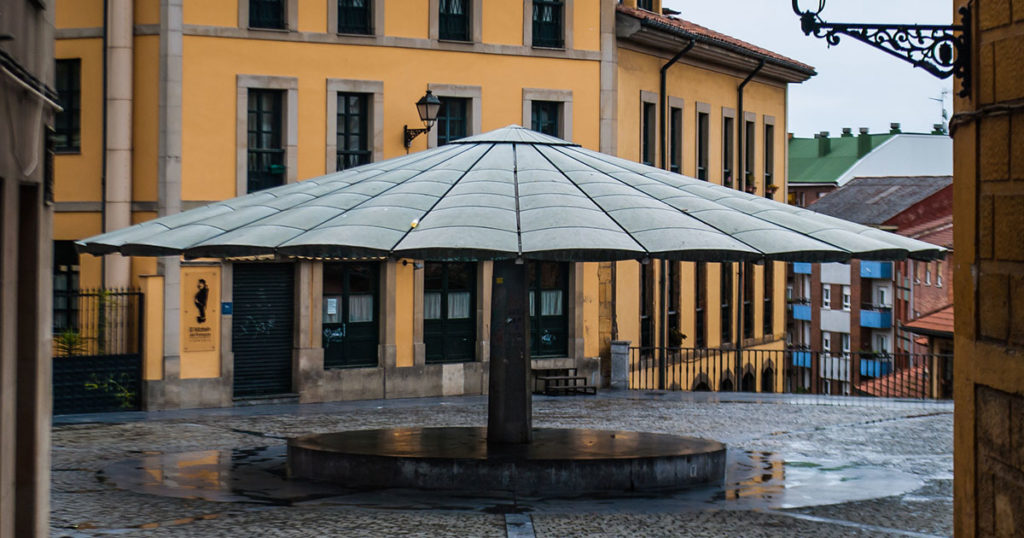
The Pola de Siero Theater Auditorium is the biggest of the three big boxy buildings that make up the cultural complex in the town of La Pola. They stand together in a well-spaced jumble on a rise at the end of the principal road through town. An old people’s home run by the Little Sisters Congregation occupies an entire block behind it, and facing the complex on the other side are the typical modern apartment buildings, crowding a crumbling old mansion that survives alongside them. What an assortment! Like so many similar towns that grew rapidly in the boom years after the late ’60s, this one is nothing if not a miscellany. It includes my small neighborhood of a few ancient farmsteads reconditioned and added onto over the years, the old town and its beautifully restored traditional houses from the 19th century interspersed with even older-looking buildings in a state of dilapidation, a neoclassical church from the mid-1800s, several monumental buildings that date back centuries, and the six-story apartment buildings that line most of the town’s streets. Thrown in with this hodgepodge, the Auditorium, along with the other two buildings of the cultural complex, should hardly stand out. Yet it was one of the first buildings I noticed when I came to live in this town, 10 months ago. It stood out not only for the airy, open feel of the high ground where it sits but also for its style. The buildings of the complex are made of green glass and steel and are tipped and turned at different angles. Are they hideous? Beautiful? Presumptuous? Loud? Original? My mother on her fall visit took pictures of the streets near my house to give an idea of her surroundings to friends back home. Some of these people are my friends too. What do you think of these buildings? I asked one of them in an email, referring to the cultural complex.
This person is well spoken and well informed. He doesn’t beat about the bush. Still, I didn’t expect his refreshingly direct reply. “They’re way more interesting than dreary upright rectangular ones,” he wrote. No jargon, no theories of architecture or urban planning. Instead, something I could understand. Way more interesting. That’s worth aspiring to. I opened my eyes, no longer on the lookout only for the old and beautiful and circumspect.
The Auditorium, inaugurated in 2011, was designed by the municipality’s Technical Office, headed for 42 years by the architect José Benito Díaz, a native of La Pola. This past November, Díaz retired, his whole career spent in Siero, the municipality of which La Pola is the capital. You must have a strong vocation for public service to spend your entire career heading a municipal planning office, a reporter commented in a newspaper interview from 2021. Díaz agreed. He had found his while still an architecture student, studying under a teacher with a social vision of the profession more than an artistic one.
In the same interview, when asked how many projects he had worked on over the years, he replied that he couldn’t say exactly. Some years, though, more than a hundred. In addition to the cultural complex, his notable projects in La Pola include the rehabilitation of the town hall and of the Palacio del Marqués de Santa Cruz, both in the city park; the rehabilitation of the Plaza Les Campes, in the old center of town; and the renovation of the Plaza del Paraguas and of the Plaza Cubierta, both designed by the architect and engineer Ildefonso Sanchéz del Río, renowned for his use of reinforced concrete. The Plaza Cubierta, where farmers still sell their goods on Tuesday, market day, was finished in 1931. When the building was inaugurated, people were afraid to enter because not a single column supported the vaulted ceiling.
Up the hill from the covered plaza is the Plaza del Paraguas. The structure there, an octagonal inverted umbrella from 1973 with a single pillar, was originally commissioned for the livestock market. Under Díaz, a team of specialists rehabilitated the monument and redesigned the plaza.
Both the Plaza Cubierta and the Plaza del Paraguas are included in the Asturias Cultural Heritage catalogue. An early project of Díaz’s, the rehabilitation of the town hall in 1984, won an award for architecture; the rehabilitation of the Plaza de Paraguas earned another award in 2021. According to a co-worker, his most emblematic project is the new National Livestock Market. New buildings made, old saved, needs met, awards won, 42 years. Not the whole picture, but pieces of a puzzle if you’re a newcomer wandering around, taking stock.
One chilly winter afternoon, I caught the sunset in the Auditorium glass. Down the hill, I skirted the Plaza Cubierta. Then onward, up the slope to the Plaza del Paraguas. Although Díaz did not design the structure in the Plaza del Paraguas, it is among those he is fondest of. “People are not aware of the work of art this structure is,” he explained to the same reporter. “For me, it has the standing that a Gothic or Roman cathedral can have. It is comparable to any unique building in Spain.”
So—a cathedral for cows, I thought, remembering its origin in the livestock market. It had been a dismal failure due to air currents, which tended to funnel through the animals sheltering under the eaves of the structure, making them restless. Now the umbrella dignifies a bus station. So, these days it’s people who gather here rather than livestock. Either way, animals passing through, bound for other places. A chill breeze blew past me. Homeward I turned, to my cozy abode. Not more interesting, but more welcoming than modern cathedrals, floating roofs, or topsy-turvy cantilevered buildings. Way more.


